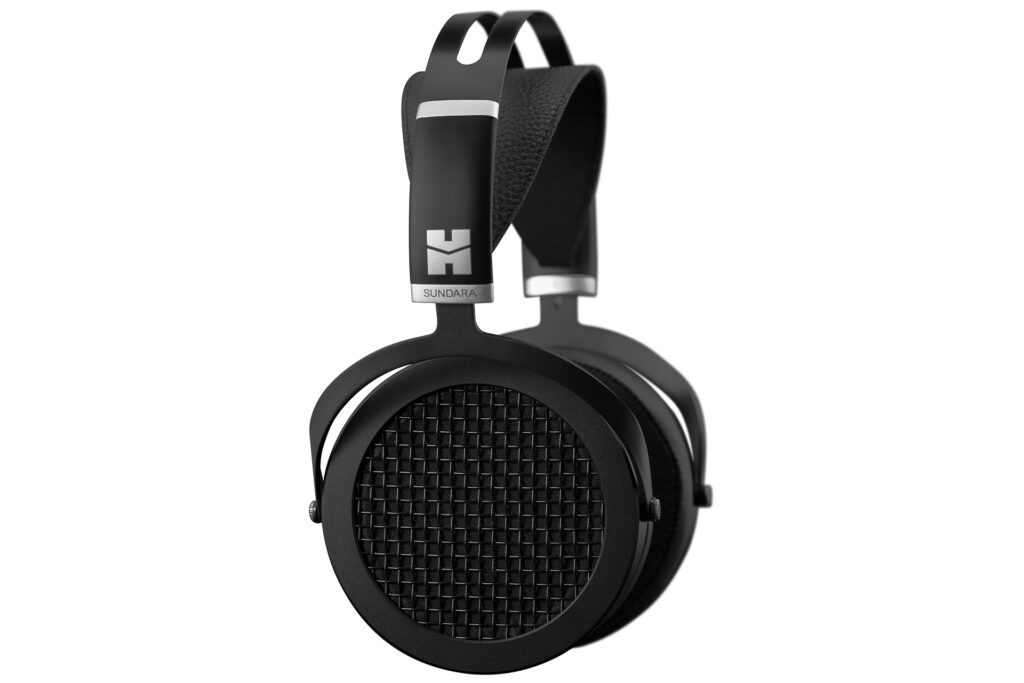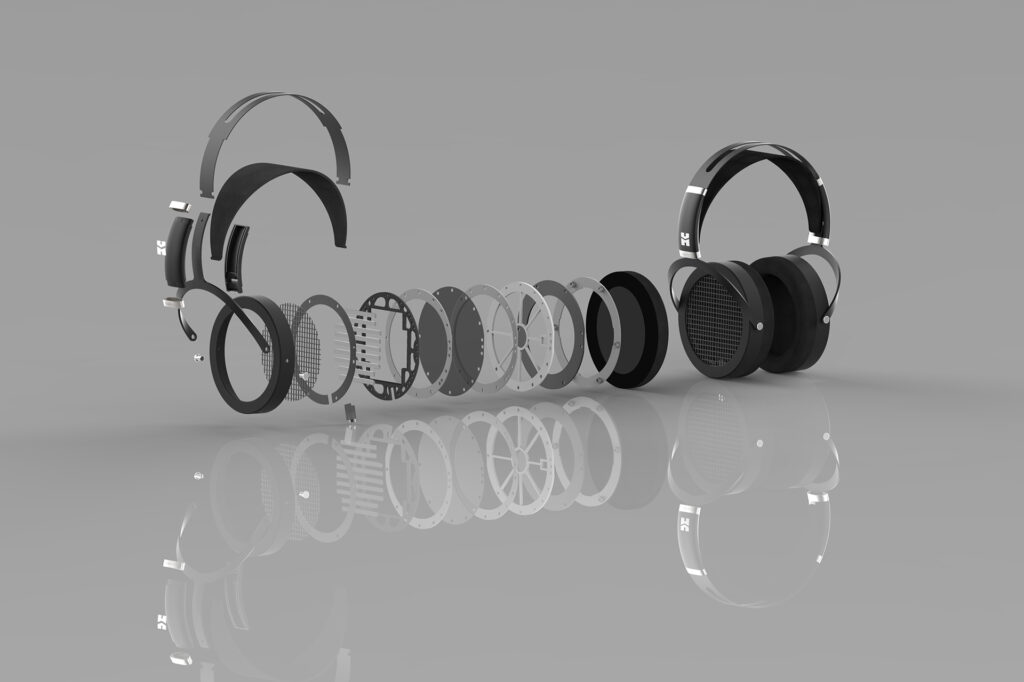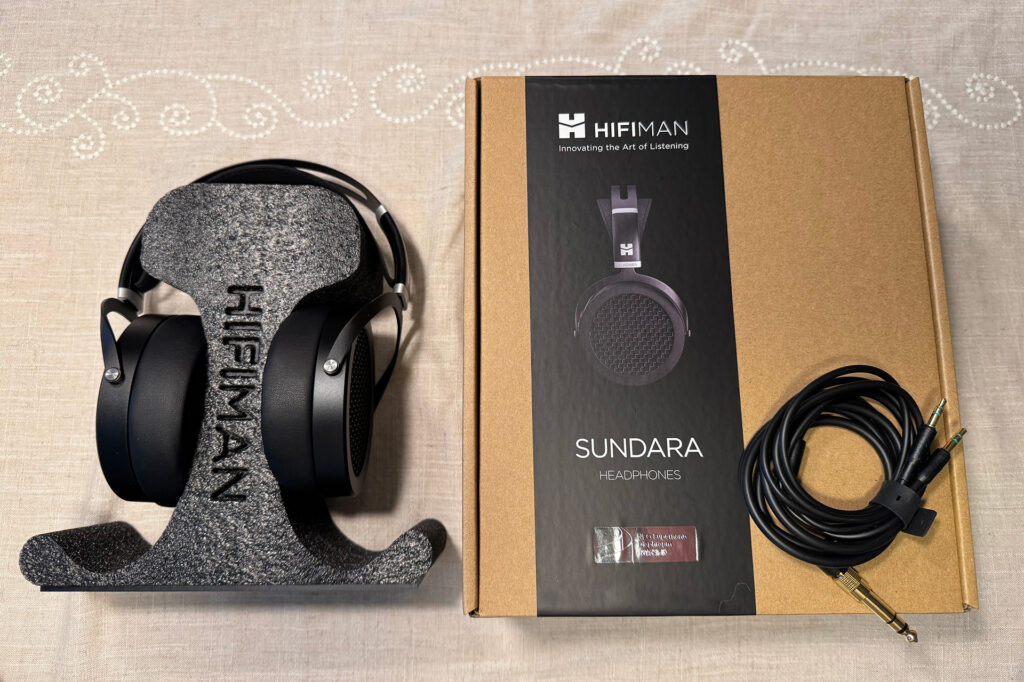Planar magnetic headphones have made significant inroads into the audiophile world over the last decade. Known for their detailed sound and fast transient response, planar headphones have traditionally demanded a premium price. The HIFIMAN Sundara stands out as an exception to this trend. Positioned as an affordable entry into planar magnetic headphones, the Sundara delivers planar magnetic performance at a price point well below most other planar magnetic headphones. I spent several weeks with the Sundara Open-Back as my “daily cans” in both casual and critical listening sessions, and I came away impressed with how much it delivers at its modest price. The Sundara is also available in a closed back version.
The HIFIMAN Sundara is an open-back, over-ear headphone, featuring planar magnetic drivers housed in a minimalist yet well-constructed chassis that shares styling cues with the rest of the HIFIMAN lineup. It is relatively light and comfortable for long listening sessions (if your ears and head are average-sized), although there are a few ergonomic quirks worth mentioning. That said, what sets the Sundara apart is how it performs sonically – and it performs well beyond its price bracket.
The HIFIMAN Sundara is available only in black with silver trim. The industrial design will be immediately recognizable to headphone aficionados as part of the HIFIMAN family, but in a slightly simplified version. The simplified aluminum and leather (leather-esque?) chassis reduces manufacturing costs, while providing a stable chassis for the planar magnetic motors.

What Makes the HIFIMAN Sundara Open-Back Headphones Special?
- The HIFIMAN Sundara series utilizes a planar magnetic driver, a step up from the dynamic drivers found in most headphones in this price range. Planar drivers are known for their speed, accuracy, and better control of the drivers, resulting in lower distortion. HIFIMAN has been refining its more expensive planar designs for years, and the Sundara benefits from this trickle-down technology.
- HIFIMAN uses an all-new NEO “supernano” Diaphragm (NsD) in the Sundara headphones. The NSD diaphragm is 80 percent thinner than prior designs. Measuring between one and two microns thick, this new diaphragm is touted as “resulting in a faster, more detailed response, while maintaining lush musicality never before possible.”
- The HIFIMAN Sundara features a metal headband with a suspended synthetic leather strap. The circumaural earcups are large and circular, with comfortable, fabric-lined pads. I typically prefer oval or teardrop-shaped circumaural earcups, but found the Sundara’s earcups to be comfortable. The clamping force was a bit much on my extra-large head, but after a week or so of wearing them and some slight tweaking, the sensation was reduced to being secure with no discomfort.
- The well-designed suspension system, coupled with light weight (342 grams), made for comfortable and non-fatiguing listening sessions. The included cable is a basic, rubber-sheathed, 3.5mm terminated cord with dual 3.5mm mono plugs, one for each earcup. It is 1.5 meters in length, which I found long enough not to be restrictive, but not so long that it became an obstacle. Lastly, the cable was non-microphonic in nature and came with a one-quarter-inch plug adapter.
- HIFIMAN states the Sundara Open-Back headphone has an easy-to-drive 32-ohm impedance, with a sensitivity of 92 dB. Frequency range is stated as 6Hz-75kHz. I had no trouble powering the HIFIMAN Sundara Open-Back headphones in my testing.
- HIFIMAN’s clever packaging includes a serviceable headphone stand. The Sundara’s packaging is quite clever, in that it includes a foam insert that can double as a headphone stand. While not as attractive, durable or sturdy as many stands you can purchase separately, it is completely functional and shows no signs of wear after a month or so of use.
Why Should You Care About the HIFIMAN Sundara Open-Back?
The HIFIMAN Sundara Open-Back headphones bring solid, planar magnetic engineering to an affordable mass market price point. The Sundara Open-Back headphones bring the speed and musicality of the HIFIMAN’s more expensive headphones to an affordable price point, while maintaining much of the performance of their more expensive headphones.

Some Things You Might Not Like About the HIFIMAN’s Sundara Open-Back Headphones
- The open-back design isn’t optimal for loud listening environments. I view the open-back design as a mixed feature, with both pros and cons. Open-back headphones are often more comfortable and have more natural soundstaging. However, most open-back headphones are weaker in the bass range, bleed sound, and are more susceptible to noise intrusion. Thankfully, the Sundaras are available in both open- and closed-back configurations, so you can choose whichever you prefer, depending on your needs.
- The HIFIMAN Sundaras were not the most comfortable headphones out of the box. I wear an extra-large hat and have a wide head, so this may not apply to you, but I found the clamping force to be uncomfortably high after a few minutes, until I adjusted the headband by slightly bending the metal portion. The earcups can pivot up and down, but do not rotate on their vertical axis. I did not find this to be a problem, but some head shapes may, as the fix of a high-performance headphone can be very personal.
- I have heard some criticism of the Sundara’s included cable. Some are critical of the lack of a balanced cable. For a $299 headphone? I think that most buyers of headphones in the under $500 range are unlikely to be using a balanced (XLR) headphone amplifier. What I am more concerned about is cable length, durability, and whether it is microphonic. The HIFIMAN Sundara’s cable was an appropriate length, seems to be holding up fine, and does not generate any signal noise when tapped, rubbed, or otherwise manipulated.
Listening to the HIFIMAN Sundara Open-Backed Headphones …
I connected the Sundaras to an Astell & Kern Kann Kube portable player, using the Sundara’s included cable. Michael Jackson’s “Thriller” kicked off my listening. This clean and well-mastered track is known for its deep, tight bass, but features many detailed sound effects from the opening montage and throughout the track. The imaging had the vocals solidly centered in between my ears. Jackson’s voice and effects were rendered with controlled clarity. I found his voice to be accurately reproduced, but the bass in the synthesized soundtrack to be on the thin side. Thankfully, the A&K player had an EQ function and I found boosting the signal from 60 Hz down about two dB provided a much more satisfying listening experience. The openness of the open-back design is compelling, but it comes with downsides – that I solved with a little EQ – so no harm, no foul.
On Norah Jones’ “Don’t Know Why,” the Sundaras rendered her vocals with a breathy intimacy that made the recording feel sonically intimate. Jones’ vocals and piano had substantial body and warmth, despite the speed and detail of the drivers. With some planar magnetic drivers, there can be some thinness, rendering the sonic portrayal as lacking body. I was concerned that the HIFIMAN Sundaras might fall victim to this, but such fears were unfounded. The subtle dynamics in her piano playing were well-articulated and layered into a wide yet quite coherent soundstage. There was a natural timbre that drew me in without sounding overprocessed or overly analytical. All these qualities combined to create an accurate and enjoyable recreation of this recording.
Musically switching gears a little bit, I played “Time” by Hans Zimmer from the Inception soundtrack. The HIFIMAN Sundara delivered the track’s slow build-up and orchestral layering with clarity and weight. The texture of the strings, coupled with the dynamics of the horns, made for a realistic orchestral experience, even at a moderate volume. While the sub-bass didn’t shake the room, the headphones conveyed a palpable sense of scale and immersion that reminded me why open-back headphones are so revered.
Will the HIFIMAN Sundara Open-Back Headphones Hold Their Value?
Given their performance-per-dollar ratio, I believe the Sundaras will hold their value reasonably well in the audiophile headphone market. HIFIMAN has already earned a strong reputation for performance headphones among audiophiles, and the Sundara provides a good portion of this performance at a very attractive price.
While newer models may introduce incremental improvements, it is unlikely there will be substantial improvements at or below this price point. As long as it remains supported by HIFIMAN, and replacement parts (such as pads and cables) remain available, I expect used units to retain decent resale value, assuming that you don’t put too much wear and tear on a wear and tear item like audiophile headphones. Our publisher, Jerry Del Colliano, is notorious for beating the hell out of his wireless headphones. Don’t be like him if you want to get some of your modest investment back on a pair of HIFIMAN Sundara Open-Back headphones.

What Is the Competition for the Sundara Open-Back Headphones?
First and foremost, the HIFI Sundara Closed-Back headphones. They are priced at $399, so $100 less than the open-back version of these HIFIMAN cans, and they have all the same features, but in a closed-back design. This brings its own tradeoffs, more bass but different (perhaps not as magical) soundstaging. Then again, you get much more sonic isolation from a closed-back design.
There are a few other notable competitors worth considering. The Sennheiser HD 600/650/6XX ($200-500) series are dynamic driver headphones with a loyal following. They offer excellent tonal balance and comfort, though they lack the speed and airiness of a planar design. Sennheiser headphones are a studio and broadcast favorite, and those traits flow through to their more consumer-grade products.
If your budget is too tight for the Sundara, the Drop x HIFIMAN HE-X4 ($129) is another budget planar option, but it doesn’t offer the same resolution or refinement as the Sundara. It also doesn’t come with as high a retail price. I briefly listened to these headphones over a year ago but, from what I recall, the Sundaras have cleaner treble, more detail and more bass than the HE-X4s. Please note: those listening notes are old, but I do remember being really impressed with the performance of these headphones at such a low retail price point.

Final Thoughts on the HIFIMAN Sundara Open-Back Headphones …
The HIFIMAN Sundara is a gateway drug into the world of planar magnetic headphones. It delivers an impressively open and resolving sound signature in a package that is largely comfortable and reasonably built for its price.
While there are a few ergonomic and build quality compromises, the sonic performance is where the HIFIMAN Sundara earns its stripes. It outperforms many dynamic headphones in its price range, and even challenges more expensive competitors. If you have a quiet space to enjoy music and want to experience planar magic without blowing your budget, the HIFIMAN Sundara is an easy recommendation to any audiophile looking for some excitement in his or her headphone setup.



